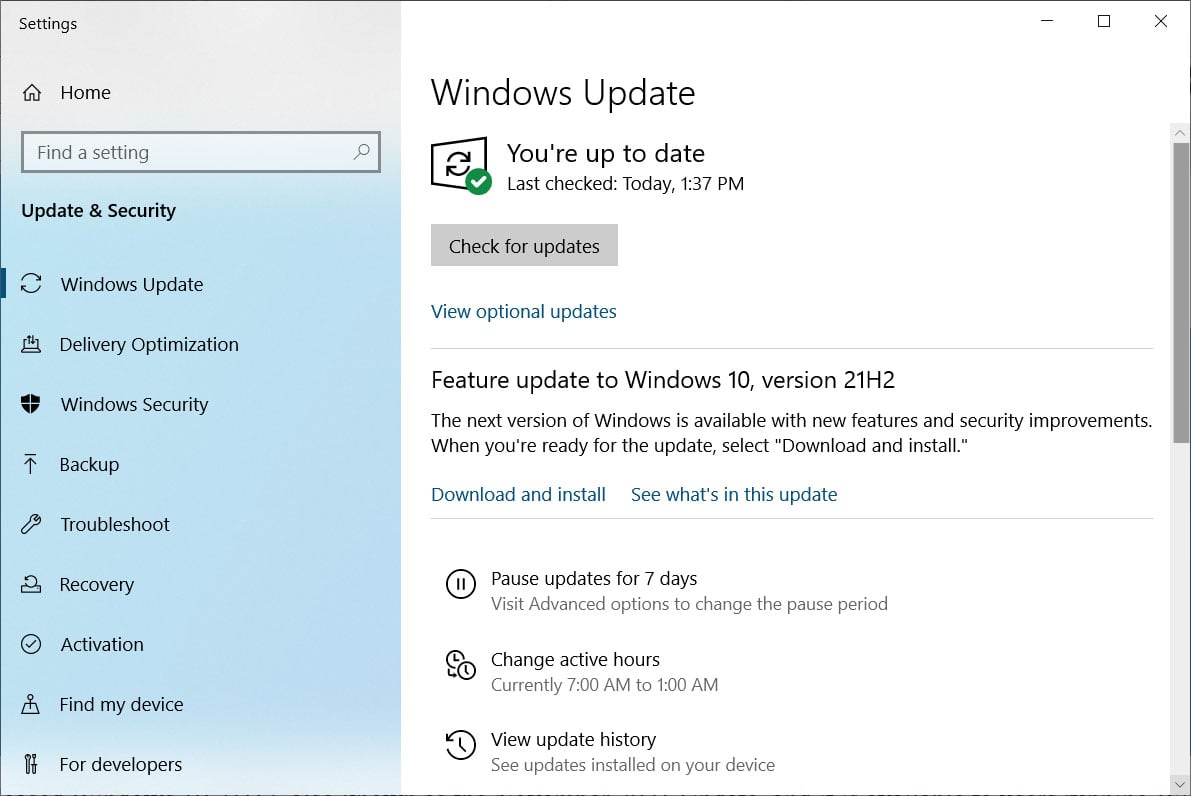
Microsoft has released Windows 10 21H2, also known as the November 2021 Update, and it is available to users running Windows 10 2004 or later as an optional update in Windows Update.
The Windows 10 21H1 feature update is a limited release with only a few new features, primarily directed at business users. However, as this is the latest release of Windows 10, and Windows 10 2004 reaches the end of support next month, it is recommended that users install the new feature update.
Windows 10 21H2 is being rolled out in stages, with it first offered as an optional update to "seekers" running version 2004 or later. Seekers are those who manually perform a check for new updates in Windows Update.
To install the Windows 10 November 2021 feature update, click on the Start Menu > Settings > Update & Security and click on the 'Check for updates' button. Windows 10 will check for new updates and then display the optional 'Feature update to Windows 10, version 21H2', which you can install by clicking the 'Download & install now" link.

This feature update is being rolled out as an enablement package for Windows 10 2004, Windows 10 20H2, and Windows 10 21H1, allowing these versions to quickly update the new feature update.
For users running older versions of Windows 10, you will need to install the full update, which will take substantially longer.
Microsoft warns that Windows 10 21H2 is being rolled out in stages, so please be patient if you do not see it immediately.
Windows users can also use the Windows 10 Media Creation tool to upgrade to the new version or create an ISO to clean install Windows 10 21H2.
What's new in Windows 10 21H2
Windows 10 21H2 is one of the smallest feature updates released by Microsoft, with only a few new features, which are outlined below.
With this release, Microsoft has added support for the WPA3 H2E (Hash-to-Element) protocol, which provides increased protection against side-channel attacks.
In 2019, researchers disclosed a new side-channel attack called "DragonBlood" that could be used to steal a WPA3 password.
After the vulnerability was disclosed, the Hash-to-Element protocol was added to WPA3's Simultaneous Authentication of Equals (SAE) authentication protocol to prevent these types of side-channel attacks.
"In response to the Dragonblood paper, IEEE 802.11 updated SAE by defining a new “Hash-to-Element” (H2E) method, as an optional alternative to the existing “Hunting-and-Pecking” method for the secret PWE (Password Element) derivation used in SAE authentication. H2E is significantly more computationally efficient and provides robust resistance to side channel attack," explained Cisco in a blog post about the security issue.
Also included in Windows 10 21H2 is the eagerly awaited GPU compute feature to the Windows Subsystem for Linux and Azure IoT Edge for Linux and Windows.
GPU compute has been the #1 most requested feature for WSL, and it allows Windows users to use their graphics card to "accelerate math-heavy workloads and uses its parallel processing to complete the required calculations faster, in many cases, than utilizing only a CPU.
To use the GPU computer feature, you will need to have Hyper-V and WSL2 installed.
Finally, this feature update improves Windows Hello for Business by supporting passwordless deployment models for easy rollouts of new machines predefined security policies.
Windows 10 transitioned to annual release cadence
With the release of Windows 10 21H2, the operating system is now being transitioned to annual feature update releases to align with Windows 11.
"We will transition to a new Windows 10 release cadence to align with the Windows 11 cadence, targeting annual feature update releases.
We are now renaming the servicing option for releases to the General Availability Channel starting with the November 2021 Update (Note: this replaces the previous "Semi-Annual Channel" term for the servicing option)."
Under this new release cadence, the next Windows 10 feature update is scheduled for release in the second half of 2022.
Microsoft states that at least one version of Windows 10 will continue to be supported through October 14, 2025.
Furthermore, Home and Pro editions of the November 2021 Update will receive 18 months of servicing and support. Enterprise and Education editions will receive 30 months of servicing and support as of today.

.jpg)
Comments
Spud422 - 2 years ago
Finally the shared printer issue is resolved! Only a month of waiting
Wbyassee - 2 years ago
Microsoft states that at least one version of Windows 10 will continue to be supported through October 14, 2025.
When will we find out which version will be supported?
Some-Other-Guy - 2 years ago
They are now on a yearly release cycle, so probably 23H2
dionv - 2 years ago
"Also included in Windows 10 21H2 is the eagerly awaited GPU compute feature to the Windows Subsystem for Linux and Azure IoT Edge for Linux and Windows."
Is this for GA, or just Insiders still? Current review of my system with 21H2 installed appears to NOT have WSLg, and a few forum posts seem to indicate that 21H2 does NOT include WSLg, and that it was only made GA in Windows 11.
Not ready to upgrade to Windows 11 (hardware-wise, and avoiding the alternate Windows version curse), so if WSLg is only available to Insiders or Win11, then I guess I will have to keep waiting.